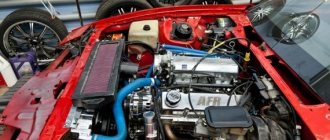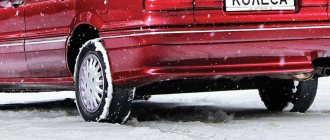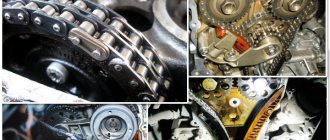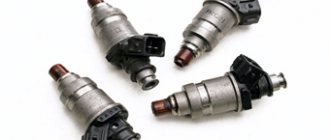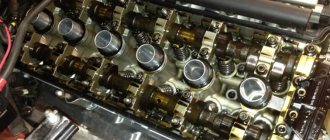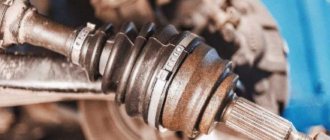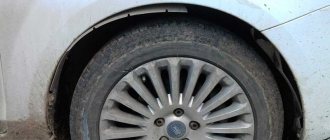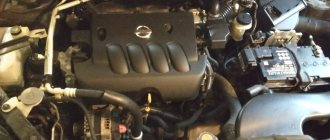It is unlikely that there will be at least one car owner who will calmly accept the appearance of extraneous knocks, noises and squeaks on his car. But they not only cause irritation and anxiety, but are also signs of wear and tear on the engine and other vehicle components, depending on the source of the sounds.
But rightly the most alarming symptom can be called the situation when the engine knocked. Moreover, such sounds have different tonality and intensity, they can be ringing, metallic, obvious and noticeably muffled. Some appear when the engine is cold, others become noticeable when the engine warms up. Knocks disappear and disappear, or are observed constantly.
There are a huge number of reasons for knocking in the engine. The machine’s motor is subject to a large number of loads, including mechanical and thermal.
Practice shows that most often extraneous noise in the form of tapping appears due to natural wear and tear, due to violation of operating rules, after poor-quality repairs or when installing low-quality parts.
What is a knock in the internal combustion engine?
To begin with, we should examine such a simple concept at first glance as a knock in the engine. This is the appearance of extraneous noise with a characteristic sound caused by the contact of various surfaces, parts and components of the motor.
Often, if the engine knocks, this indicates symptoms of critical wear and gap formation. Characteristic unpleasant noises usually appear when the permissible gap sizes increase by 2 times or more. The force of impact and contact directly depends on the size of the gap.
That is, here we are talking about the collision of engine elements with each other. At the same time, during impacts, the load on the area where the components of the internal combustion engine are in contact increases sharply. This significantly accelerates wear and tear, and leads to the need to deal with repair issues in the very near future.
The increase in gap can be influenced by:
- initial gap size;
- engine parts;
- materials used;
- acting loads;
- efficiency of the lubrication system;
- performance of the cooling system;
- driving style, etc.
Because of this, some parts can knock, but at the same time withstand several tens of thousands of kilometers without causing any serious or dangerous consequences. This applies more to timing knocks. And others can cause a breakdown after 5-20 kilometers. Here, the most vulnerable elements are the cylinder-piston group and the crank mechanism.
There are even situations when the engine begins to knock, although the clearances remain normal and there is no severe wear. Similar symptoms may indicate:
- detonation and heavy loads on the engine;
- misalignment of engine elements;
- jamming of mechanisms;
- oil wear.
If you encounter knocking noises, they should never be ignored. Even when it seems that the car is behaving normally, the engine pulls and does not lose power.
Preliminary diagnosis
When you hear unfamiliar sounds coming from the engine compartment of your car, you need to make sure that their source is the car’s engine.
To do this you need:
- Press the clutch pedal and disengage the gearbox and transmission. This eliminates the influence of these components on engine operation.
- Drive the car onto an overpass or install it in a viewing hole in the garage.
- Quite often, the cause of extraneous sounds is engine mounts, a generator, or a water pump. They need to be checked. It is advisable to temporarily dismantle any suspicious parts.
- If after these operations the engine continues to knock, then this is where the problem lies.
Finding the source of the knock
The first step when the engine knocks is to find the source of the extraneous noise. The primary task of the car owner is to find the node where this unpleasant and uncharacteristic sound for a working car is formed.
Professionals can determine the source of the problem based only on the tone and approximate location. For diagnostic purposes, it is extremely useful to have a stethoscope in your arsenal of tools. Also, some craftsmen make homemade devices for wiretapping.
But here it is worth understanding that tonality is considered only an indirect sign, since noise on different engines with the same malfunctions can manifest themselves differently. The design features of the power unit should be taken into account, and the breakdown should be diagnosed not by sound, but by a comprehensive check.
Based on the nature of the extraneous knock, it can be divided into several categories. Namely:
- permanent;
- periodic;
- with different frequencies;
- episodic.
In the case of episodic tapping, they should already be called impacts that occur unevenly.
There is often a direct connection between the knock that appears in the internal combustion engine and the revolutions made by the crankshaft. The faster the engine starts to spin, the more intense the knocking occurs, and its frequency becomes higher. The frequencies sometimes coincide with the frequency of the shaft, or are different, which makes it easier to hear uncharacteristic noise. Depending on the current operating mode of the motor, the intensity may vary.
When the speed increases and the load on the engine increases, the load on the components of the crank and gas distribution mechanism increases in parallel. Then the worn parts will correspondingly knock with greater force and intensity than when the engine is idling. And here it is important to notice whether the noise increases as the speed increases.
Do not forget that as the engine speed increases, the oil pressure in the lubrication system increases. And here the lubricant can act as a damper, which reduces the intensity of sounds, even when the load on the internal combustion engine increases. Therefore, when diagnosing, it is necessary to simultaneously take into account the current engine temperature. When the engine is hot, the knocking noise may increase as the oil becomes thinner. And on a cold internal combustion engine, knocking may not appear at all. Or the opposite situations happen.
What to do if the engine knocks while driving
If the power unit starts knocking, you need to find the cause and eliminate it. You can do this yourself or contact specialists.
Attention!
In some cases, the driver decides that the problem lies in the engine, so he sends his car for overhaul. But it may turn out that this is not the reason.
When an extraneous sound is detected on the road, you should not continue driving, since there is a high probability of a sad outcome. It is better to go to the nearest service station and contact specialists. But if the noise does not increase and can be heard in the hydraulic compensator, timing belt or injection pump, you can continue on your way.
The engine can knock for various reasons, which are not difficult to eliminate, the main thing is to correctly identify them. If you can’t do this yourself, you should turn to professionals.
Potential Causes
The appearance of a metallic knock in the engine is not at all a pleasant sound or a positive symptom. This situation should alert the car owner and make him think about carrying out diagnostic measures.
Having roughly understood how you can determine what exactly is knocking in the engine, you need to listen to your internal combustion engine, walk with a stethoscope through different areas and test the operation of the engine in different modes. This will allow you to understand when knocking occurs and at what moments they increase or decrease. If you cannot conduct wiretapping yourself, contact specialists who will carry out diagnostics using special equipment that determines the sources and nature of knocking noises.
As for the potential causes of unpleasant tapping noises, most often the culprits should be sought among:
- cylinder pistons;
- piston pins;
- camshaft;
- crankshaft;
- main bearings;
- connecting rod bearings;
- valves;
- cylinder head, etc.
It is worth noting that when two elements of the gas distribution mechanism, which are made of durable metals, wear out, the knocking noise can remain unchanged for a long time. If a soft element comes into contact with a harder one, then the sounds will quickly intensify.
You should consider the situations in which engines may knock, and also identify the most dangerous sources of unusual noise.
Cold engine
Many car owners have experienced a knocking sound when starting the engine. Moreover, sometimes only engine knocking was observed upon direct start-up, and after a short warm-up it disappeared.
Some will immediately say that in such a situation, worn valves may be knocking on a cold engine. But don't rush to conclusions. It is believed that knocking noises during startup, which then disappear, are not something dangerous. That is, the car can be used. Experienced drivers only recommend warming up the engine before driving.
But here a logical question arises as to why there is a knocking noise when it’s cold, but after warming up it disappears. This is due to natural wear and tear of internal combustion engine parts. But with expansion caused by heating, the gaps return to their normal state.
The most dangerous causes of knocking
1. Pistons are knocking in the cylinders.
The knocking of the piston, distinguished by a dull tone, is clearly audible in the cylinder block and is sometimes accompanied by a kind of clicking sound.
The engine knocks and clatters as a result of thermal expansion of the piston, usually “in the cold,” at low engine speeds, as well as when the gas is suddenly released while driving. A knock occurs as soon as the gap becomes larger than 0.3 mm. 2. The piston pins are knocking.
The sound of the piston pins knocking is “metallic”, high-pitched and slightly ringing. This sound is clearly audible if you over-throttle or press the accelerator hard to accelerate. The place where the sound occurs is considered to be the cylinder block; the gap is about 0.1 mm.
The malfunction can also be determined by unscrewing the spark plug. Without a spark plug, the fuel in the cylinder does not burn, which means there is no load on the piston.
Detonation often occurs due to the use of fuel that is unsuitable for this type of engine, as well as during extreme overloads (steep uphill, long descent).
3. Main bearings and crankshaft liners are knocking.
The metallic knock of the engine, characteristic of this case, is a little muffled and is heard from the crankcase. Knocking elements are especially audible at low speeds of a “cold” engine during acceleration and at the moment of releasing the gas. The size of the gap between the neck and the liner is equal to the minimum 0.1-0.2 mm. A drop in oil pressure to a critical level makes the sound louder, regardless of the operating mode.
Often, valve knocking is caused by the use of low quality motor oil, or one that does not match the type of power unit.
4. Connecting rod bearings are knocking.
The sound of faulty connecting rod bearings is similar to signs of main bearing problems, but is more distinct. If the sound intensity increases, repairs must be made urgently. Operation of both gasoline and diesel engines with unsuitable connecting rod bearings is prohibited - the engine may “seize” at any time.
Driver actions when knocking occurs
We will have to repeat this truism for the umpteenth time, but if a knocking noise occurs while driving the car, it is recommended to check the current oil level. To do this, you will have to stop and use the probe to perform this simple procedure.
If the knocking appeared on a cold engine, but then disappeared, there is nothing to worry about. You can calmly, without overloading the engine, drive to a garage or car service center, carry out diagnostics and find the cause.
When a knocking noise appears when the engine is hot and gradually increases, in such a situation it is better to stop the vehicle, turn off the engine and call a tow truck. Trying to get to the service center on your own is potentially dangerous, since with every kilometer the cost of repairs will increase in proportion to the destruction of engine components.
Regardless of the causes and provoking factors, any knocking in the engine becomes a reason to carry out diagnostics and carry out some repair work. Depending on how correctly you can determine the causes of knocking, you will be able to minimize the financial and time costs of repairs. Some faults require surface dismantling and simple manipulations. Others involve complete disassembly of the engine, which requires a lot of time, effort and certain skills. It is not always worth taking on such work yourself.
Typical causes of ringing “fingers” during normal operation of the internal combustion engine
If the “fingers” knock during acceleration in the Kalina, the mass air flow sensor may have failed. If it is not working correctly, then the ECU will receive incorrect information and issue incorrect commands. Another reason is an incorrectly set ignition timing. For this reason, the point at which the fuel will burn maximum is approaching TDC. This leads to increased pressure in the combustion chamber. If the “fingers” knock when accelerating on a Ford Focus, then the knock damping sensor may have failed. It's definitely worth checking this item. If it stops working, it should be replaced.
Poor quality fuel is the cause of all the troubles that happen to cars. This has already been described in detail above. It should be noted that knocking fingers is not always a problem that has formed during the use of the car. There are situations when a car comes from the factory with incorrectly connected sensors. This ultimately leads to detonations and knocking. This problem is especially dangerous because the engine is being run-in and detonation is especially harmful for it. It should be excluded.
Knocking noise when accelerating and turning left but not CV joint
Please help me find a solution to the problem. When accelerating sharply in all gears, a sound is heard as if the CV joint has turned on the left side. The same sound comes when turning left. The fault was with the outer left CV joint, I replaced it, but the problem was not solved, I replaced the inner left one. the problem has not gone away (((if you accelerate slowly and smoothly, then everything is super quiet and perfect. As soon as the slipper hits the floor, there’s an immediate knock. GNE gearbox
or maybe the right one? Have you looked?
What does the rack have to do with it? Then why does it knock during acceleration, but not during smooth acceleration?
The right one didn't look. But even when turning to the right there is no such knock (
Not the rack, I know the knock of the rack by heart. We had to repair it.
when turning left, the right side is loaded (I would look just in case) do you know how a grenade cracks?
There's something different here. Suspicion that something is wrong with the checkpoint. I lifted it on a lift, my friend was driving, I was near the wheel, when I turned the steering wheel to the left there was a very strong crunching sound. But only on the left side. Moreover, when you align the wheels, everything goes smoothly and works cleanly. And also, at good speed, when the car lifts up on bumps. and the suspension goes down, this sound also appears. But as soon as the car returns to four dice, the sound disappears.
Of course I know. That's why I say that the sound is very similar. Tomorrow I will touch the right side. On the left side, all the CV joints remained and they are normal, as it turned out.
The bearing? The box shouldn't - nothing changes in it when the wheels turn.
Last edited by Vint4x4; 05/18/2017 at 11:08 am.
Then why does the lift crack when turning? Try hanging each side on the jack in turn and turn it at speed - what happens.
